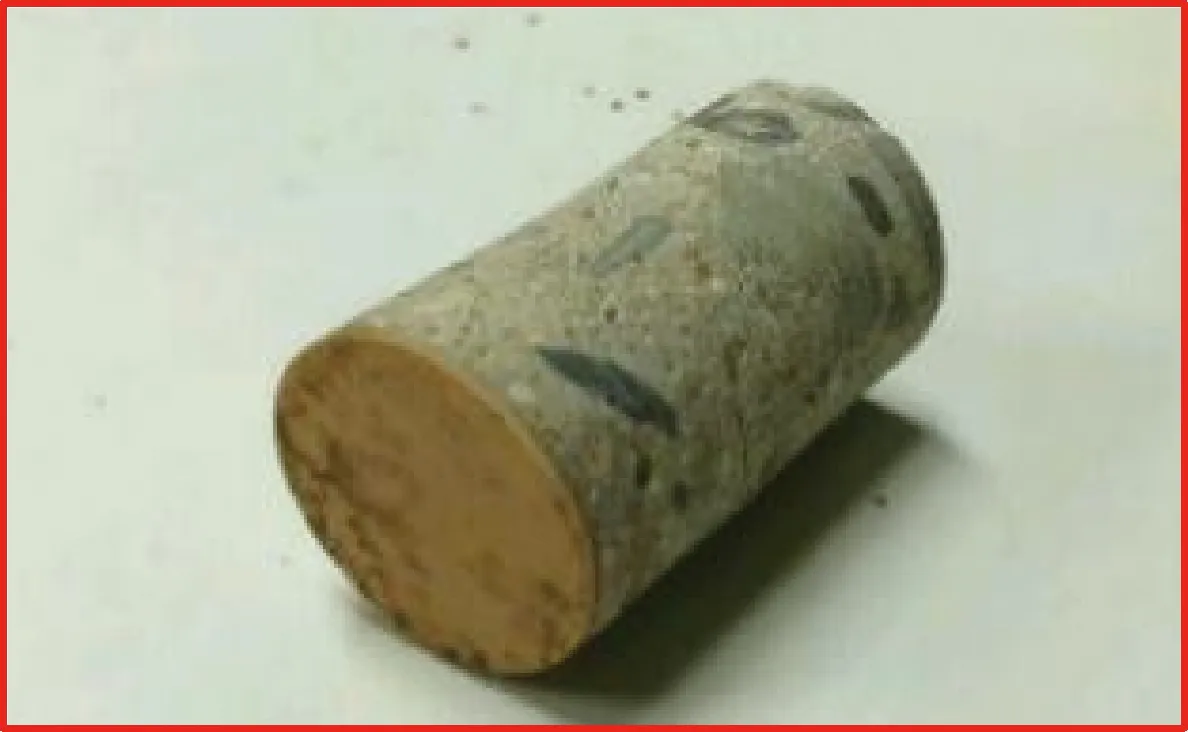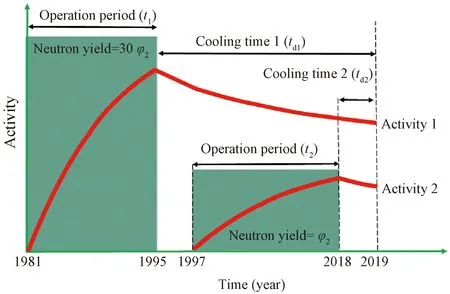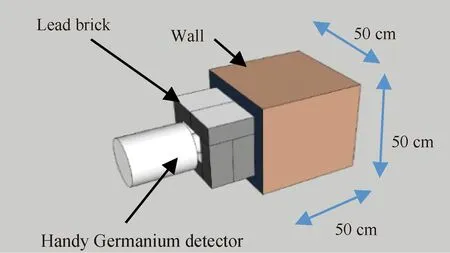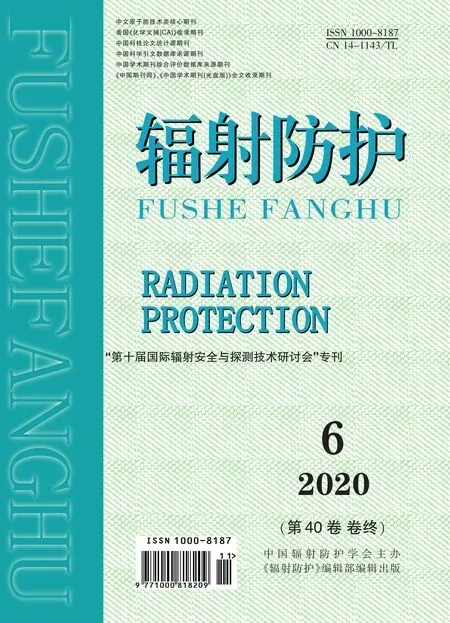Long-lived neutron-induced radioisotopes in OKTAVIAN facility concrete wall after 38 year-operation
Fajar Panuntun,Shingo Tamaki,Sachie Kusaka,Fuminabo Sato,Isao Murata
(Graduate School of Engineering,Osaka University,Yamadaoka 2-1,Suita,Osaka,565-0871,Japan)
Abstract:An intense 14 MeV neutron source facility named OKTAVIAN was installed in the A15 building,Osaka University in 1981.Along the operation period,new radioisotopes with various half-life have been produced as neutron activation products in its concrete wall shield.In this work,we investigated the concrete wall in the heavy irradiation room of OKTAVIAN using gamma spectrometry method to discover the presence of radioisotope having large half-life value (long-lived radioisotope) as neutron activation products.Computational simulations were performed prior to measurement to predict the presence of long-lived radioisotopes by employing MCNP5 and FISPACT codes.A pre-calibrated Germanium detector with high energy resolution was employed to measure the concrete.Several long-lived activation products have been observed such as 152Eu,54Mn,65Zn,22Na and 60Co.The activity of each radioisotope was derived after estimating the detector efficiency using MCNP5.As a result of the measurement and analysis,the followings are concluded:(1) Though presence of activation products represents radiological risk to everyone who performs an experimental activity in the irradiation room of the OKTAVIAN facility,the present result shows that past experiments were carried out safely without any significant additional exposure dose coming from the wall for the last 38 years.(2) The approximated total fluence of D-T neutrons to the wall was successfully estimated from the produced radioisotope,152Eu,because it has the longest half-life of 13.5 years among the observed radioisotopes.(3) From the results of (1) and (2),it could be possible to estimate the total activity of the concrete wall in the OKTAVIAN facility,which is very essential and important information,because this would be very valuable for decommissioning or disposal of the facility in the future.
Key words:OKTAVIAN;concrete wall shielding;long-lived neutron-induced product;total fluenced D-T neutron
1 Introduction
OKTAVIAN is an intense 14 MeV neutron generator machine located in the A15 building,Osaka University,Japan.It has been operated for almost four decades since its first operation in 1981.This facility was designed for students and researchers for their neutron irradiation experiments.During the long irradiation process,14 MeV incident-neutron interact with sample and other material nearby like concrete wall shielding as well.As a result,new radioisotopes with various half-life have been produced as neutron activation products which are commonly produced through activation reaction.
It could not be avoided that a lot of elements in the concrete wall became radioactive following the OKTAVIAN operation.Since an earthquake struck Osaka prefecture and near area on June 18th2018,some OKTAVIAN machine components are broken now.OKTAVIAN is now in temporary shut-down for repairing.It is thus the best moment to investigate the presence of the long-lived activation products in the wall without any interfering activity coming from short-lived activation products because they were decayed completely while the machine was in temporary shut-down period.However,long-lived activation products produced may be in very low activity and may require a long time counting process.
Studies on neutron activation product in the concrete have ever been presented in the literature[1-3].In this work,we investigate the presence of long-lived radioisotopes by in situ measurement and sampling method of the heavy irradiation room concrete wall of OKTAVIAN facility.In addition,we predict numerically long-lived radioisotopes produced that may exist in the wall,however,may be difficult to measure.
It is expected from the present study that several long-lived radioisotopes supposed as activation product would be observed.This work would also confirm the radiation safety regarding the external dose received by students and researchers who conducted experiments in this facility.The total fluence of incident 14 MeV neutrons along the operation period would be estimated from the longest half-life radioisotope.Hence,the total activity of the concrete wall could be estimated,which would be helpful in the case of decommissioning the facility in the future.
2 Basic theory
The accumulated activity of activation product of interest at the end of neutron irradiation can be expressed by Equation (1).If the nuclide of interest has a very long half-life,cooling time (td) effect can be ignored.
A=N0φσ(1-e-λti)e-λtd
(1)
where produced activityAof interest depends on the total number of nuclides of the parent nuclideN0,neutron flux intensityφ,activation cross-sectionσ,decay constantλ,irradiation timeti,and cooling timetd.Whereas,the total fluenceΦof incident neutrons can be expressed by
Φ=φti
(2)
3 Experimental procedures
3.1 Activation product prediction
3.1.1Concrete element composition
We retrieved data from JAEA-Data/Code 2007-006 to utilize the chemical composition of the ordinary concrete wall that was presented by ANSI (American National Standard Institute) as shown in Table 1 below.

Tab.1 Ordinary concrete chemical composition[5]
3.1.2Neutron spectra
MCNP5 was chosen to figure out the neutron spectra of the concrete wall in the heavy irradiation room of OKTAVIAN facility.The room was modeled as a simple geometry with 1 m thick wall having composition as shown in Table 1.We set a small cylinder cell on the wall in front of the tritium target at the same location of the sample we took as a neutron spectra monitor.The code was executed until the statistical error was acceptable.The 14 MeV incident-neutron source description was retrieved from the evaluated data available in the OKTAVIAN facility.
In order to see the detail neutron flux intensity distribution in the concrete wall,neutron spectra were calculated at four depths.Since the concrete sample is 45 mm long,for simplicity,neutron spectra were estimated in the concrete for every 10 mm of the depth.From the result,there is no significant difference among calculated neutron spectra in the concrete from its surface to 40 mm depth.Thus,we average those four neutron spectra to estimate the activation product in the next step.
3.1.3Activation product prediction
The historical operation of OKTAVIAN is described as follow.In 1981 to 1995,it was operating with rotating tritium target (yield 3×1012n/s).Then,it was broken and stopped for two years because of an earthquake.In the second operation period from 1997 to 2018,OKTAVIAN was utilized with a fixed tritium target (yield 1×1011n/s).
The second computational software called FISPACT was employed to perform activation simulation.FISPACT is an inventory code that has been developed for neutron-induced activation calculations for materials in fusion devices.However,FISPACT can be used to perform inventory calculation as well as neutron activation.The numerical irradiation experiment was carried out with the concrete sample having the same composition as shown in Table 1.We listed up predicted activation products based on the historical operation above as shown in Table 2,which were expected to be observed by measurement.

Tab.2 List of predicted long-lived activation products in the OKTAVIAN concrete wall by FISPACT
3.2 Concrete sample measurement
The highest neutron flux intensity in OKTAVIAN was experimentally observed in 0° angular angle with respect to the deuteron beam.We then took a concrete sample from the wall located 230 cm in front of the tritium target as shown in Figure 1.The sample was in a cylinder shape with 25 mm diameter and 45 mm length.Its weight was 50 gram.Here we calculated the concrete sample density which was 2.26 gr/cc.
The sample under investigation was moved to the counting room to discover the presence of long-lived activation products.An 8k multi-channel analyzer (MCA-8000D,AMPTEK,INC) was coupled with a high energy resolution germanium detector (Canberra Model GEM 09175-PS).The sample was placed several mm in front of the detector and covered with massive lead shields.
As a result,a radioisotope,152Eu,was observed.The counting process required long time to obtain a reliable result (small uncertainty),because the activity of the sample is very low.The absolute activity of152Eu was calculated after estimating the detector absolute efficiency by means of MCNP5.

Fig.1 Concrete wall sample under investigation
The152Eu activity was then employed to estimate the total neutron fluence,because the half-life of152Eu is so long that152Eu could keep the irradiation history for decades as shown in Figure 2.To complete the purpose,we sent a sample to an external company for chemical analysis in order to know the fraction of152Eu nuclide in the concrete sample.According to the chemical analysis,the152Eu concentration was determined to be about 0.9 ppm.Here we got the absolute activity of the long-lived radioisotope152Eu was 0.006 49 Bq/gr.

Fig.2 Approximated irradiation pattern of 152Eu activity in the wall
Actually,precise real-time schedule of all the irradiation can be seen from OKTAVIAN annual reports,but it consumes an extremely long time to collect all of the operation data since the year 1981.Hence,we assumed approximated irradiation time schedule as shown in Figure 2.The neutron flux intensity as the reference was retrieved from common neutron yield data that have ever been observed experimentally at OKTAVIAN facility.The highest nominal neutron production rate ever achieved by OKTAVIAN machine was 3×1012n/sec at the rotating tritium target.This is employed in Operation period (t1) in Figure 3.The OKTAVIAN was broken and stopping its operation due to two strong earthquakes struck in the Kansai area,Japan,in 1995 and 2018.For the former earthquake,several years later,OKTAVIAN was successfully fixed and continued its operation from 1997.For the latter,OKTAVIAN is now under repair and is planning to restart from this October.For Operation period (t2) from 1997 to 2018,the rotating tritium target was replaced with a fixed small target which can produce neutrons,of which the highest nominal neutron production rate experimentally observed was 1 × 1011n/sec.The ratio of neutron flux intensity at 230 cm in front of the tritium target is 1/30.Therefore,we finally assumed the averaged neutron flux intensity was 30φf(shuō)or Operation period (t1) andφf(shuō)or Operation period (t2).The cross-section value was retrieved from JENDL4.0.The Maxwellian Average cross-section value of151Eu over thermal neutron energy was employed[7].
After obtaining the averaged neutron flux intensity for the entire operation by comparing the experimental activity of152Eu and calculated one,the total amount of neutron fluence was estimated by applying Equation (2).In this case,time irradiation (ti) was obtained by summing the time of two operation period (t1+t2).Here we finally obtained the total 14 MeV incident-neutron fluence as 1.833×1012neutrons per cm-2at 230 cm in front of the tritium target,and 1.218×1018neutrons produced for the entire operation.
3.3 Wall measurement
The second measurement was carried out in front of the concrete wall in the heavy irradiation room of OKTAVIAN.The heavy irradiation room condition is shown in Figure 3.It was performed by means of the same MCA coupled with PGT Model IGC 40190 handy germanium detector.The detector was positioned 0 mm in front of the wall and shielded by lead bricks.

Fig.3 Heavy irradiation room of OKTAVIAN
The measurement was performed for three days to obtain good statistical accuracy.As a result,five long-lived activation products were observed,i.e.,152Eu,54Mn,65Zn,22Na and60Co.In addition,an ordinary concrete wall that had never been exposed to neutron radiation in OKTAVIAN was measured to confirm natural background gamma-ray spectra.

After obtaining the detector efficiency,the efficiency curve was normalized to be able to be the same as the absolute activity of152Eu from the sample concrete estimation.We finally estimated the activities of the rest four radioisotopes of54Mn,65Zn,22Na and60Co as 0.006 13;0.000 69;0.000 193 and 0.002 46 Bq/gr,respectively.

Fig.4 Approximated model in detector efficiency estimation
4 Discussion
According to FISPACT calculations,most of the predicted radioisotopes are a short-lived nuclide that will disappear within several days through decaying process.Several long-lived nuclides i.e.55Fe,39Ar,40K,and22Na appeared as the top four dominant radioisotopes.Among them,two radioisotopes55Fe and39Ar were not observed in the wall measurement.The gamma-ray intensity of55Fe is too low,about 1×10-7percent at 126 keV.Whereas39Ar was difficult to measure because it was in a gaseous state and doesn’t emit any gamma-ray.It should be noted that it was assumed that there was only small number of activation product,40K,due to its extremely long half-life,1.248×109year and not so large cross-section with thermal neutron.
In the low background circumstances (concrete sample measurement),the nuclide of interest,152Eu,was observed in an extremely low level of activity since its total count rate of the sample was only 5.39 count per second at several mm in front of the Ge detector cap.This count rate was definitely the same as the one in the background measurement previously performed.Emitted gamma-rays from152Eu thus compete with natural background activity.Consequently,it took 23 days for the measurement of the sample to achieve its counting uncertainty less than 7% at peak energy,122 keV,as the strongest gamma-ray intensity of152Eu.
The detector efficiency estimation thus plays a crucial role in estimating the152Eu activity.It was estimated under 0.02% of uncertainty at 122 keV.However,each gamma-ray spectrum of152Eu results in different absolute activity of152Eu due to its extremely low activity.Some of them might be overlapped with other unknown peaks since the obtained activity was too high compared to the one deduced by other energy peaks.Because of this troublesome condition,the absolute activity of152Eu was evaluated by averaging the two gamma-ray peaks of 122 keV and 344 keV as the strongest two gamma-rays emitted from152Eu.
Other than152Eu,there are four long-lived activation products of54Mn,65Zn,22Na and60Co existing even in a small activity in the wall measurement,however,they were not observed in the concrete sample measurement.Table 3 shows these five long-lived radioisotopes and their estimated activity.Their activities were very low,meaning that the total count rate of wall measurement was only 60.52 count per second at 0 cm distance.This count rate was a little bit larger than ordinary concrete wall count rate of 41.17 count per second under the same measurement set-up.
Moreover,the total activity of the wall is now possible to be estimated.The easiest way is to perform activation simulation using FISPACT.A simple simulation was performed with concrete containing element listed in Table 1 including small fraction of europium.Since the dimensions of the heavy irradiation room of OKTAVIAN are 450×500×420 (L×W×H) cm3,and by assuming the fast neutrons are penetrating up to around 10 cm in the wall,we estimated the total activity of the wall is 1.39 MBq/m3which is the averaged value till 10 cm in depth.Out of this total activity,about 97.88% is from40K.

Tab.3 Five long-lived radioisotope in the concrete
5 Conclusion
We have successfully investigated OKTAVIAN concrete wall and observed at least five long-lived radioisotopes152Eu,54Mn,65Zn,22Na,and60Co as activation products of 14 MeV incident-neutrons after almost four decades of operation.Most of them were produced via (n,) nuclear reaction in several centimeters in depth after 14 MeV neutrons were thermalized in the concrete wall.Since we found they appeared in very low activity,we could confirm that our past experiments were most likely conducted safely.There was no significant additional exposure dose to workers for the last 38 years coming from the wall of the heavy irradiation room in the OKTAVIAN facility.Among the observed radioisotope,152Eu had the longest half-life which was suitable to estimate the total fluence of D-T incident-neutron along the operation period.It should be preliminary information to estimate the total activity of the whole concrete wall in the OKTAVIAN facility for the future disposal purpose.
Acknowledgment:The authors would like to thank all people in the OKTAVIAN facility for helping us to complete this work.

